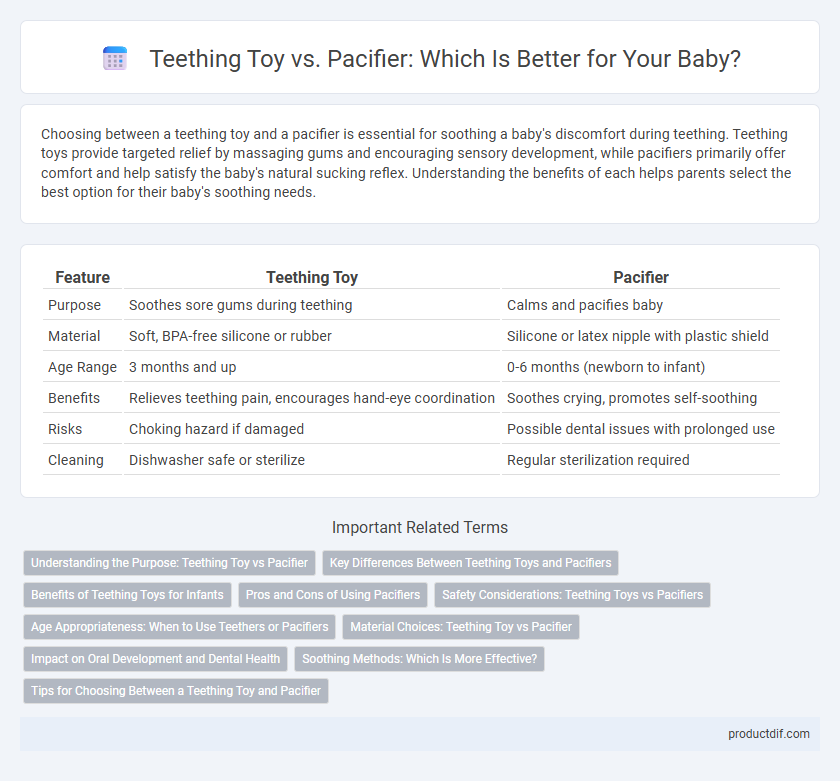Choosing between a teething toy and a pacifier is essential for soothing a baby's discomfort during teething. Teething toys provide targeted relief by massaging gums and encouraging sensory development, while pacifiers primarily offer comfort and help satisfy the baby's natural sucking reflex. Understanding the benefits of each helps parents select the best option for their baby's soothing needs.
Table of Comparison
| Feature | Teething Toy | Pacifier |
|---|---|---|
| Purpose | Soothes sore gums during teething | Calms and pacifies baby |
| Material | Soft, BPA-free silicone or rubber | Silicone or latex nipple with plastic shield |
| Age Range | 3 months and up | 0-6 months (newborn to infant) |
| Benefits | Relieves teething pain, encourages hand-eye coordination | Soothes crying, promotes self-soothing |
| Risks | Choking hazard if damaged | Possible dental issues with prolonged use |
| Cleaning | Dishwasher safe or sterilize | Regular sterilization required |
Understanding the Purpose: Teething Toy vs Pacifier
Teething toys are designed to soothe and massage a baby's gums during the teething process, promoting healthy oral development and providing relief from discomfort. Pacifiers primarily serve to satisfy a baby's natural sucking reflex, offering comfort and helping to calm them. Understanding the distinct functions helps parents choose the right product to address either teething pain or the need for soothing.
Key Differences Between Teething Toys and Pacifiers
Teething toys are designed primarily to soothe a baby's sore gums during the teething phase by providing safe, textured surfaces for chewing, while pacifiers focus on satisfying a baby's natural sucking reflex and providing comfort. Unlike pacifiers, which can potentially affect dental development if used excessively, teething toys promote gum massage and oral stimulation without interfering with natural oral growth. Materials for teething toys are often more varied and textured, such as silicone or rubber with ridges, whereas pacifiers usually feature a smooth silicone or latex nipple.
Benefits of Teething Toys for Infants
Teething toys provide infants with soothing relief by massaging sore gums and encouraging healthy oral development, unlike pacifiers which primarily offer comfort through sucking. These toys promote fine motor skills and sensory exploration with varied textures and shapes, aiding cognitive growth during teething. Crafted from safe, non-toxic materials, teething toys support safe chewing and reduce the risk of dental issues, making them essential for infant oral health.
Pros and Cons of Using Pacifiers
Pacifiers help soothe babies by satisfying their natural sucking reflex, often reducing crying and promoting better sleep, but extended use can lead to dental issues such as misaligned teeth and increased risk of ear infections. They are convenient, easy to clean, and can serve as a tool for comforting during teething, yet reliance on pacifiers may interfere with breastfeeding and speech development if used excessively. Balancing pacifier use with other soothing methods is essential to minimize potential negative effects while providing comfort to infants.
Safety Considerations: Teething Toys vs Pacifiers
Teething toys often feature BPA-free, non-toxic materials designed to withstand gnawing without breaking into small parts, reducing choking hazards compared to some pacifiers. Pacifiers must meet strict safety standards with soft, flexible nipples and ventilation holes to prevent suffocation risks, but improper use or wear can increase safety concerns. Regular inspection and cleaning of both teething toys and pacifiers are essential to maintain hygiene and prevent bacterial buildup that could harm infants.
Age Appropriateness: When to Use Teethers or Pacifiers
Teething toys are ideal for infants around 3 to 12 months who are beginning to develop their first teeth, offering safe relief from gum discomfort. Pacifiers suit newborns up to 6 months, providing soothing comfort and aiding in sucking reflex development. Parents should transition from pacifiers to teethers as the baby's oral needs evolve, ensuring appropriate use during each developmental stage.
Material Choices: Teething Toy vs Pacifier
Teething toys are primarily made from BPA-free silicone, natural rubber, or wood, offering durability and safety for infants to chew on during teething. Pacifiers commonly use medical-grade silicone or latex for the nipple, combined with plastic shields designed to prevent choking hazards. Both products prioritize non-toxic, hypoallergenic materials, but teething toys often emphasize textured surfaces to soothe gums, while pacifiers focus on smooth, flexible materials for sucking comfort.
Impact on Oral Development and Dental Health
Teething toys promote healthy oral development by massaging gums and encouraging chewing, which helps strengthen jaw muscles and improve coordination. Pacifiers can provide soothing comfort but prolonged use may lead to misalignment of teeth and bite issues, increasing the risk of dental malocclusions. Choosing age-appropriate teething toys with safe materials supports natural oral growth, while limiting pacifier use minimizes potential negative effects on dental health.
Soothing Methods: Which Is More Effective?
Teething toys provide targeted relief by massaging sore gums and promoting healthy oral development, making them highly effective during the teething phase. Pacifiers offer comfort by satisfying the natural sucking reflex, which can soothe but may not directly alleviate gum pain. Choosing between the two depends on whether the goal is to comfort or actively soothe teething discomfort in babies.
Tips for Choosing Between a Teething Toy and Pacifier
Choose a teething toy if your baby shows signs of gum discomfort and needs soothing through chewing textured surfaces made of safe, non-toxic materials like silicone or natural rubber. Opt for a pacifier when the goal is to satisfy your baby's natural sucking reflex, which helps calm and comfort them during sleep or stressful moments. Consider factors such as age appropriateness, safety certifications, and ease of cleaning to ensure the product supports your baby's developmental needs and hygiene.
Teething Toy vs Pacifier Infographic

 productdif.com
productdif.com